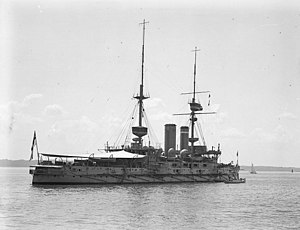HMS Implacable (1899)

HMS Implacable after the addition of fire control platforms to her foremast and mainmast.
|
|
| History | |
|---|---|
|
|
|
| Name: | HMS Implacable |
| Ordered: | 1897 Programme |
| Builder: | Devonport Dockyard |
| Laid down: | 13 July 1898 |
| Launched: | 11 March 1899 |
| Completed: | July 1901 |
| Commissioned: | 10 September 1901 |
| Decommissioned: | 1919 |
| Fate: | Sold for scrapping 8 November 1921 |
| General characteristics | |
| Class and type: | Formidable-class pre-dreadnought battleship |
| Displacement: |
|
| Length: |
|
| Beam: | 75 ft (23 m) |
| Draught: | 26 ft 9 in (8.15 m) |
| Propulsion: | Water tube boilers, 2 × vertical triple expansion engines, 2 shafts, 15,500 ihp (11.6 MW) |
| Speed: | 18 knots (33 km/h) |
| Range: | 5,500 nautical miles (10,200 km) (approx) at 10 kn (19 km/h) |
| Complement: | 780 |
| Armament: |
|
| Armour: |
|
| Notes: | Cost £1,122,636 |
HMS Implacable was a Formidable-class battleship of the British Royal Navy, the second ship of the name. Commissioned in September 1901, she was assigned to the Mediterranean Fleet and served with the fleet until 1908. After a refit, she transferred to the Channel Fleet, then onto the Atlantic Fleet in May 1909. By now rendered obsolete by the emergence of the dreadnought class ships, she was assigned to the 5th Battle Squadron and attached to the Home Fleet in 1912.
Upon the outbreak of World War I, Implacable, along with the squadron was assigned to the Channel Fleet. After operations with the Dover Patrol, she served in the Dardanelles Campaign, in support of the Allied landings at Gallipoli. Apart from a brief spell in England in March/April 1916 for a refit, she remained in the Mediterranean until June 1917, supporting firstly the Italian Navy and then the French Navy. Returning to England, she was laid up until March 1918, and then served as a depot ship for the Northern Patrol. After the war, she was decommissioned and eventually sold for scrap in 1921.
HMS Implacable was laid down at Devonport Dockyard on 13 July 1898 and launched on 11 March 1899 in a very incomplete state to clear the building way for construction of battleship HMS Bulwark. Implacable was completed in July 1901.
Implacable and her sisters were similar in appearance to and had the same armament as the Majestic and Canopus classes that preceded them. She and her sister ships are often described as improved Majestics, but in design they really were enlarged Canopuses; while the Canopus class took advantage of the greater strength of the Krupp armour employed in their construction to allow the ships to remain the same size as the Majestics with increased tonnage devoted higher speed and less to armour without sacrificing protection, in Implacable Krupp armour was used to improve protection without reducing the size of the ships.Implacable and her sisters thus were larger than the ships of the two preceding classes, and enjoyed both greater protection than the Majestics and the higher speed of the Canopus class. Implacable's armour scheme was similar to that of the Canopuses, although, unlike in the Canopuses, the armour belt ran all the way to the stern; it was 215 feet (66 m) long and 15 feet (4.6 m) deep and 9 inches (230 mm) thick, tapering at the stem to 3 inches (76 mm) thick and 12 feet (3.7 m) deep and at the stern to 1.5 inches (38 mm) thick and 8 feet (2.4 m) deep. The main battery turrets had Krupp armour, 10 inches (250 mm) on their sides and 8 inches (200 mm) on their backs.
...
Wikipedia
